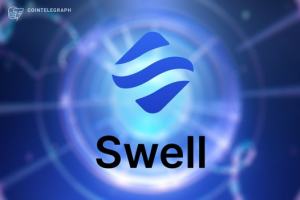你可知道?
代币化市场规模预计将超过3000亿美元,释放10万亿美元以上的市场潜力。
您可以跻身顶尖之列,使用 Merkeleon 创建自己的代币化财物渠道。
Merkeleon 加密货币买卖软件开发因质量、可定制性和创新而在行业领导者中享有盛誉。
系好安全带,了解推出成功的代币化财物渠道的诀窍。
了解代币化
什么是代币化?
代币化已经成为一种颠覆者,挑战了传统的财物所有权概念。
它是将有形财物改变为区块链上的数字代币。
想象一下,一幅莫奈的画作、一套奢华的顶层公寓,或者一家备受瞩目的出资基金的股份,只需点击几下就可以轻松切割、转让和买卖。
区块链上的这种数字表明便是咱们所说的代币。
但这为什么重要呢?
从物理所有权到数字所有权的改变带来了无与伦比的可拜访性和流动性。
财物不再受到地域限制或官僚障碍的束缚,变得民主化,为更广泛的受众参加曾经为少数精英保留的出资打开了大门。
沉思:财物所有权的民主化将怎么重塑传统的金融权利动态?
代币化能否真实弥合特权阶层与国际社会之间的距离?
代币化的突出特色之一是其对安全性和可拜访性的双重许诺。
区块链技能是代币化的支柱,保证每笔买卖都是加密安全和透明的。
区块链记载的不行变性使得欺诈和操纵几乎不行能。
但是,在这种强大的安全性下,可拜访性并没有受到影响。
部分所有权有助于个人拥有一份高价值财物,打破财政障碍并使出资组合多样化。
这是包容性与安全性相遇的范式改变。
代币化的长处和缺陷
代币化是一股革命性的力气,重塑了咱们感知财物以及与财物互动的方式。
但与任何突破性技能相同,它也有其一系列的优势和挑战。
长处
- Liquidity boost. Tokenization transforms traditionally illiquid assets, such as real estate, into a fluid, tradeable form. This newfound liquidity can potentially revolutionize investment strategies, making it easier for investors to enter and exit markets.
- Fractional ownership. Tokenization introduces the concept of fractional ownership, meaning individuals can own a fraction of high-value assets. This democratization of ownership broadens investment opportunities, fostering financial inclusion.
- Global accessibility: Through blockchain’s decentralized nature, tokenization boosts global access to assets. Investors worldwide can engage in markets that were once confined to specific regions, promoting a more interconnected and borderless financial landscape.
- Efficiency and transparency. Smart contracts automate traditionally cumbersome processes, reducing the need for intermediaries. The result is increased efficiency and transparency in transactions, minimizing the risk of fraud and errors.
Cons
- Security concerns. While blockchain is renowned for its security, the platforms supporting tokenized assets may still be susceptible to cyber threats. Striking the delicate balance between accessibility and security remains an ongoing challenge.
- Regulatory uncertainties. The regulatory landscape for tokenized assets is still evolving. Navigating these uncertainties demands a careful approach, as legal frameworks struggle to keep pace with the rapidly advancing technology.
- Market speculation. Tokenization can attract speculative behavior, leading to volatile market conditions. Understanding and managing these fluctuations become crucial for both investors and platform operators.
- Integration hurdles. Integrating tokenization into existing financial systems poses technical challenges. Seamless interoperability requires overcoming hurdles in technology and cooperation among stakeholders.
Real-World Assets for Tokenization
In tokenization, the canvas extends far beyond digital currencies. Real-world assets, from tangible properties to exclusive investments, are being ushered into the blockchain era. Let’s explore assets that can be tokenized, and how this process is reshaping traditional notions of ownership.
Scope of Tokenization: From Penthouse to Picasso
Real Estate Tokenization
Real estate, historically characterized by high entry barriers, is now undergoing a radical transformation. Tokenization permits property owners to break down the value of their assets into tradable tokens, furnishing fractional ownership and democratizing real estate investment.
The iconic Manhattan property, 594-unit luxury condominium, was tokenized, allowing investors to purchase and trade fractions of the property on the blockchain.
Art Tokenization
Exclusive art collections are no longer confined to the walls of elite galleries. Tokenization makes the fractional ownership of artworks possible. Thus, art enthusiasts worldwide can invest in and share ownership of valuable pieces.
“Everydays: The First 5000 Days,” a digital artwork by Beeple, was tokenized and sold as an NFT (Non-Fungible Token) for a record-breaking $69 million, showcasing the power of art tokenization.
Private Equity Tokenization
Traditional private equity investments are often limited to institutional players. Tokenization breaks down these barriers, making private equity accessible to a broader range of investors, creating a more inclusive investment landscape.
SPiCE VC tokenized its venture fund, which enabled investors to trade digital tokens representing ownership stakes in a portfolio of early-stage companies.
Global Trade Tokenization
Tokenizing real-world assets extends beyond physical objects. Businesses can tokenize ownership stakes to promote the trading of these digital representations on a global scale. This has the potential to redefine how we perceive and engage in cross-border trade.
IBM and Maersk’s TradeLens platform leverages blockchain to tokenize shipping containers, improving transparency and efficiency in the global logistics and trade industry.
Market for Tokenized Assets
The tokenization market is not just a niche trend; it’s a powerhouse set to redefine the global economy. Recent projections suggest that the tokenization market is poised to reach over USD 300 billion, representing a fraction of the colossal 10+ trillion-dollar market potential.
The trajectory is clear – tokenization is on the rise. Analysts predict sustained growth, with the market expected to play a pivotal role in the future of finance. The ability to fractionalize ownership and enhance liquidity positions tokenized assets as a cornerstone of modern investment strategies.
Tokenization is tearing down geographical barriers, opening the market to the global audience. This trend is shaping a more interconnected and accessible financial landscape.
Also, the market is witnessing a diversification of tokenized assets beyond real estate and private equity. From art to intellectual property, the spectrum of tokenized assets is expanding, providing investors with a broader array of options.
In the race for market dominance, innovation takes center stage. The integration of blockchain technology and smart contracts is driving efficiency and transparency. Tokenization platforms are continually evolving, presenting novel solutions to age-old financial challenges.
Reflection Point: What if you could launch your tokenization platform? The diverse landscape suggests that there is room for innovation and specialization. The next section will guide you through the steps to turn this idea into reality.
How to Launch Asset Tokenization Platform
Launching your own asset tokenization platform might seem like a daunting task. Fear not – we’re here to guide you through the process step by step.
- Define Your Niche and Objectives. Clearly define the type of assets you aim to tokenize and the objectives of your platform. Whether it’s real estate, art, or private equity, understanding your niche is important.
- Comply with Regulations. Familiarize yourself with the regulatory requirements of the jurisdictions where you plan to operate. Prepare all the documents.
- Select Blockchain Technology. Select a suitable blockchain technology that aligns with your platform’s goals. Consider factors such as scalability, security, and the complexity of integration.
- Develop Smart Contract. Develop smart contracts to automate the issuance, distribution, and trading of tokenized assets. This maintains transparency and efficiency in transactions.
- Add User Authentication and Security. Implement strong user authentication and security measures. It includes identity verification and data encryption to protect user information.
- Develop Tokenization Platform. You have two options – build your platform from scratch or partner with a reputable software development company. The latter offers a faster route to market with ready-made solutions.
Shortcut to Success: If building a tokenization platform from scratch seems complicated, consider an alternative approach. White label crypto exchange software by Merkeleon is a ready-made solution that features a customizable software, along with legal, banking and marketing assistance from renowned partners.
- Design User-Friendly Interface. Design an intuitive and user-friendly interface. Make sure that users can navigate the platform seamlessly.
- Integrate Payment Gateways. Add reliable payment gateways to facilitate smooth transactions. Supporting various payment methods enhances the user experience.
- Test and Assure Quality. Conduct rigorous testing and quality assurance to identify and rectify any bugs or vulnerabilities.
- Launch and Market. Launch your platform and implement a robust marketing strategy. Leverage social media, partnerships, and industry events to create awareness.
Popular Asset Tokenization Platforms
Understanding the existing players in the field provides valuable insights into the diverse features and available products. As we explore these platforms, consider their possibilities:
- Polyma
此时快讯
【加密货币相关股票低开 MicroStrategy跌超6%】金色财经报道,美股开盘,道指开跌约85点,标普500指数开跌0.5%,纳指开跌0.82%。加密货币相关股票低开,Marathon Digital(MARA.O)开跌超10%,Riot Blockchain(RIOT.O)跌超10%,Coinbase(COIN.O)跌近7%,MicroStrategy(MSTR.O)跌超6%。




